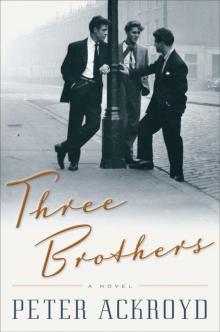- Home
- Peter Ackroyd
Venice Page 4
Venice Read online
Page 4
At the close of one of these Ascension ceremonies, in 1622, there was a violent earthquake in Venice. Just as the doge and his courtiers returned from their voyage of celebration, a slow and regular thunder beneath the earth lasted for several seconds. Everything trembled but nothing, apart from a chimney, fell. There have been other quakes in the lagoon. It is an unstable area in every sense. An earthquake is recorded in 1084, when the campanile of S. Angelo was dislodged. Towards the end of the twelfth century there were simultaneous upheavals in Saint Mark’s Square and on the island of Torcello, suggesting that there is a “fault” lying between them. There was a great earthquake on Christmas Day 1223, and then again in 1283 when the shock was followed by a great inundation. On 25 January 1384, another earthquake set all the church-bells of Venice pealing at the same time; it was followed by another shock on the following day, and these quakes were repeated at intervals over an entire fortnight. The Grand Canal was empty, but the streets were full of water.
The weather of Venice is sea-weather; the air is damp and salt-laden, conducive to fog and mist. If the climate is equable, that may in part be the position of Venice. Averroes, the twelfth-century philosopher, was the first to calculate that Venice was at a latitude of forty-five degrees, at the middle point between the equinoctial and the northern Pole. It is another example of the extraordinary balance of Venice between the geographical regions of the earth. The climate is mild, compared with much of North Italy, because it is environed by the sea. The spring is delicate and fresh, the energetic wind blowing from the Adriatic. The summer can be sultry and oppressive but, once the sun has gone down behind the Friulian mountains, the air is freshened by the breezes from the sea. The autumn is the true season for Venice. It has an autumnal air, the air of melancholy and departure. The Venetian painters, Carpaccio and Bellini, bathed their canvases in an effulgent autumnal light.
There is, especially in autumn, the possibility of rain. A subdued greyness then haunts the air, and the sky is the colour of pearl. The rain can be persistent and torrential. It soaks through the most protective clothing. It can be blinding. Then the rivers may burst their banks, and the rising waters around Venice turn to a jade green. The best description of the Venetian rain is found in Henry James’s The Wings of the Dove, where he describes “a Venice of cold lashing rain from a low black sky, of wicked wind raging through narrow passes, of general arrest and interruption, with the people engaged in all the water-life huddled, stranded and wageless.…” The city of water is blockaded by water, as if the natural elements were pursuing their vengeance against the most unnatural city.
The “wicked wind” may come from several points. An east wind blows in from the sea, refreshing in the warmer months but crueller in the colder seasons of the year. A wind from the north-east, the bora, brings the colder air from the northern region of the Adriatic. A humid wind comes from the lagoon, known as the salso because of its saltladen content. Some people say that it smells of the algae and seaweed of the surrounding waters. The salt and damp penetrate the houses of Venice; the paint flakes, and patches of plaster fall from the walls. The bricks crack and eventually crumble.
There are gusts of wind that pass very quickly, and eddies or squalls of circulating air. Sir Henry Wotton wrote of “flashing winds.” All this is of the nature of the sea. There is a south-westerly wind, too, once called garbin. It may be of this wind that Saint Bernardino of Siena wrote in 1427. He asked a correspondent, “Were you ever at Venice? Sometimes of an evening, there comes a little wind which goes over the face of the waves and makes a sound upon them, and this is called the voice of the waters. But what it signifies is the grace of God, and the breath breathed forth by Him.” Even the weather of Venice was once deemed sacred.
But the most celebrated wind is the scirocco, the warm wind that comes from the south-east and can persist for three or four days. There is a scirocco di levante and a scirocco di ponente, a hot scirocco and a cool scirocco; there is even an elusive wind called the scirocchetto. The scirocco itself has been blamed for the Venetian tendency towards sensuality and indolence; it has been accused of instilling passivity and even effeminacy within the citizens. Why should people not be moulded as much by climate as by history and tradition? The outer weather can make or unmake inner weather.
Yet some weeks of the winter can be harsh, a potent reminder of the Alps and the northern snows. The most frequent weather lament concerned the bitter cold. In the winter of 1607–08 those who went fowling in the lagoon were on occasions frozen to death, and there were reports of travellers being surrounded and killed by packs of starving wolves. At the beginning of the eighteenth century came a famous “Year of the Ice” in which provisions were brought to the frozen city by sledge. In other winters the lagoon also froze, and the Venetians could walk over to the mainland. In 1788 great bonfires were lit on the Bacino, the basin of water in front of the piazzetta; stalls and booths were erected on the ice, in the Venetian equivalent of a Frost Fair. In 1863 great sheets of ice went up and down the Grand Canal, flowing with the tide, for a month. Venice was then truly the frozen world, the ice covering the houses and palaces as well as the water. The light was blinding. Venetian houses were not built for the cold; the great windows and the stone floors of the larger dwellings made them almost intolerable during the blizzards of winter. Yet there is still something inexpressibly delightful about Venice in the snow, the whiteness creating an enchanted kingdom where what is fluid has become crystal; the quiet city then becomes wholly silent beneath the panoply of snow.
But there are winter weeks of not quite snow and not quite rain. These may become the weeks or days of fog. The iridescent mist or haze is then enveloped by the myriad fogs that creep in from the sea. The grey Istrian stone becomes an outpost of the fog, a sentinel of consolidated fog looming out of the gloom. As the Esquimaux have many words for ice, so the Venetians have many names for the fog—nebbia, nebbietta, foschia, caligo. In the midst of the nebbia, it is as if heavy rain-clouds had come to rest upon the earth and water. Nothing can be seen or heard. The fog sometimes shrouds the city so that the only sounds are those of bells and muffled footsteps; if you take the vaporetto, or water-bus, that goes around the city you disappear within the white curtain about fifty yards (about 45 m) from the shore; all that is visible of Venice are the posts carrying lights. The city only rises before you when you arrive at the next stage.
There are portents for flood. The air becomes heavy and still; the roar of the sea can be heard breaking against the Lido. The waters in the canals stir uneasily, and become more green with the influx of the sea. The tide is driven forward by the wind. The water rises to the edge of the fondamenta but then, more alarmingly, it begins to well up beneath the city itself. It spouts up through the storm drains and between the paving stones; it seeps through the foundations, rising higher and higher; it washes against the marble steps of the churches. The city is at the mercy of waves that seem to be of its own making. When the sirens sound, Venice prepares for another acqua alta.
This high water, flooding the fondamenta and the campi, making a lake of Saint Mark’s Square, invading houses and hotels, is not unusual in the city. One chronicler gave an account of a great flood in 589, although assuredly there were many before that date. They may have been so common that they deserved little notice. Other floods are recorded in 782 and in 885, when water invaded the entire city. They have been occurring ever since. In 1250 the water rose steadily for four hours and, in the testimony of a contemporary, “many were drowned in their houses or died of the cold.” It was believed that the floods were provoked by demons and bad spirits, while the only protection lay in invocations to the saints who guarded Venice. At a later date there was less recourse to supernatural help. In 1732 the area of the piazzetta, facing the lagoon, was raised by one foot (0.3 m) on a calculation that the sea at Venice rose three inches (76 mm) in every century. This was an underestimate.
The acqua alta is part of a natural cycle, o
ccurring when wind and tide and current converge in what is for Venice a fatal embrace; the bora and the scirocco can both cause surges of storm in the sea. There is also the phenomenon of the seiche, an oscillation or standing wave in the relatively shallow waters of the Adriatic. But if Venice is sinking, it is in some measure due to the removal of water by industry from artesian wells. When the water was taken from the silt and the clay, the water table was lowered—and, with it, Venice. The deepening of waterways within the lagoon, and the reclamation of marsh-land, have also increased the danger of flooding.
There are several inundations in every century, therefore, but in recent years they have been increasing in size and frequency. In the 1920s there were 385; in the 1990s there were 2,464. In November 1966, the flood reached a height of six feet four and a half inches (1.94 m). The scirocco blew for two days, keeping the murky and polluted water locked within the lagoon. At the time some believed that it would mean the death of Venice.
When the rain came, it was collected within the stone gutters of the churches and houses; it ran through the pipes and then through conduits until it reached the underground cisterns beneath every campo. There the water filtered through a body of sand before penetrating the well shaft. It was fresh and pure. The wells, or pozzi, were ubiquitous. At the middle of the nineteenth century there were still 6,782 remaining in the city, Byzantine or Gothic in construction. An immense well was sunk in the fifteenth century, in the middle of Saint Mark’s Square. Two great public cisterns were built in the courtyard of the ducal palace, from where the water-carriers or bigolanti would carry their precious commodity. They were the peasant women of the Friuli, who wore bright skirts, white stockings and hats of straw or felt; they wandered barefoot through Venice, with their copper buckets, calling out “acqua—acqua fresca.” It was a mournful, as well as a melodious, cry.
For a city built upon water, water itself was sacred. It is what in the gospel of John is called “living water.” The well-heads themselves were highly decorated as a symbol of their significant content. They were embellished by fragments of altars, pieces of religious statuary, and the stones of ancient temples, as a token of their spiritual presence. There were accounts of miracles being performed by or beside the wells. In the plague of 1464 a monk was saved from extinction by a cup of water drawn for him by a knight from a local well. The knight was later identified as Saint Sebastian and, from that time forward, the pozzo became known as Saint Sebastian’s Well. Water is holy. The Byzantine well-heads were sculpted with a range of religious symbols, including the cross and the palm tree; they were cylinders of marble, that might have been glimpsed in any eastern city. The Gothic wellheads, which resembled the capitals of great pillars, displayed figures both naturalistic and grotesque. Yet the wells often ran dry. Venice, on water, was often in need of water. After storms the wells were marred by salt water. It was a general practice for boats to be despatched to the rivers Bottenigo and Brenta in order to pick up fresh supplies. Towards the end of the nineteenth century artesian wells were established on the mainland to guarantee a more bounteous flow.
Water was the staple of life, and so the wells became central to the social routine of each parish. The iron lid that closed the mouth of each well was opened at eight in the morning, so there were always knots of people beside it during the day. It is the most common view in photographs of “old” Venice. The well defined the intimacy and density of the parish. Water has always been the great unifier and leveller, and in many respects Venice was considered to be an egalitarian city. The well was a symbol of public beneficence, a visible token of the wise stewardship of the city.
But of course water is the life and breath of Venice’s being in quite another sense. Venice is like a hydropic body filled with water, where each part is penetrated by another. Water is the sole means of public transport. It is a miracle of fluid life. Everything in Venice is to be seen in relation to its watery form. The water enters the life of the people. They are “fluid”; they seem to resist clarity and precision. When the more affluent Venetians built villas on the mainland, they always chose sites as close as possible to the River Brenta. The Venetian painter, Tintoretto, loved to depict flowing and gushing water; it expressed something of his own spirit. In the work of Giorgione, and of his Venetian school, there are constant allusions to fresh and running water, to wells and pools and lakes. In myth and folklore water has always been associated with eyes, and with the healing of eyes. Is it any wonder, then, that Venice is the most visually seductive of all the cities of the world?
The endless presence of water also breeds anxiety. Water is unsettling. You must be more alert and watchful in your perambulations. Everything shifts. There is a sense of otherness. The often black or viscous dark green water looks cold. It cannot be drunk. It is shapeless. It has depth but no mass. As the Venetian proverb states, “water carries no stains.” This formless water has therefore been used as a metaphor for the human unconscious. In his essay, “The Visions of Zosimos,” Carl Jung relates that the spirit is hidden in water like the fish. Venice has been depicted as a fish. This wondrous water, infused with spirit, represents the cycle of birth and death. But if water is the image of the unconscious life, it thereby harbours strange visions and desires. The close affiliation of Venice and water encourages sexual desire; it has been said to loosen the muscles, by human imitation of its flow, and to enervate the blood.
Yet Venice reflects upon its own reflection in the water. It has been locked in that deep gaze for many centuries. So there has been a continuing association between Venice and the mirror. It was the first city to manufacture mirrors on a commercial scale, and by the seventeenth century was fashioning the largest mirrors in the world. The plate glass for mirrors had been created by the end of the fifteenth century. Two of the greatest of all Venetian artists, Giovanni Bellini and Titian, painted young women in the act of gazing at themselves in a mirror. In both of the paintings there is a mirror poised behind the head, and one raised towards the face. The date of both paintings has been given as 1515, only eight years after the government of Venice licensed the making of mirrors on the island of Murano. The artists were publicising Venetian commodities or, rather, they shared the Venetian preoccupation with luxury goods. Yet at the same time they were contemplating in painterly terms the contrast between the true surface and the glassy surface, a duality of which they were well aware in the world all around them. The young woman might have been Venice herself, sitting and admiring rather pensively her own reflection.
The image in the mirror may in some sense be a guarantee of identity and of wholeness. The root of narcissism lies in anxiety, and the fear of fragmentation, which may be assuaged by the sight of the reflection. The Virgin Mary, in the Book of Wisdom, is lauded as “a spotless mirror of God”; Venice always associated itself with the Virgin. But of course the image in the mirror is a false self; it is hard, abstract and elusive. It has been said that the Venetians are always aware of the image of themselves. They were once masters of the display and the masquerade. They were always acting. One of the favourite pastimes of Venetian audiences in the eighteenth century was the use of opera glasses trained upon each other.
It is a place of doubleness, and perhaps therefore of duplicity and double standards. Travelling on the newly built railway Richard Wagner was intent upon “looking down from the causeway at the image of Venice rising reflected from the waters beneath,” when his companion “suddenly lost his hat out of the railway car window when leaning out in delight.” The reflection is delightful because it seems to be as substantial and as lively as that which is reflected. When you look down upon the water, Venice seems to have no foundations except for reflections. Only its reflections are visible. Venice and Venice’s image are inseparable.
In truth there are two cities, which exist only in the act of being seen.
3
Mirror, Mirror
There is in Venice an abiding attachment to the surface. It has become c
ommonplace that in the city only the fronts of houses were worth embellishment or decoration. Most of the Gothic façades are simply that—screens that bear no relation to the organic structure of the buildings themselves. It is one of the strangest aspects of a city that in certain respects resembles an ornamental shell. The rich plaster and stucco may conceal decaying brickwork, and Ruskin speculated on the “duplicity” of Saint Mark’s where internal and external ornamentation were quite distinct. The city was built in brick but disguised by marble.
It seemed to matter not at all that behind the sumptuous façades the grand Venetian houses were often cold, dirty and uncomfortable. In similar fashion, among the owners of these houses, there was an outward show of prodigality combined with avarice and penny-pinching at home. That was the Venetian way. It was not at all usual to invite guests, for example, into the house itself; that inward space was confined to relatives and the most intimate friends. The English poet, Thomas Gray, remarked that in their domestic lives Venetians were “parsimonious to a degree of nastiness.”
Honour was important in Venetian society, as in others, but the mark of honour was what was known as bella figura; it might be interpreted as the art of keeping up appearances. One of the great engines of Venetian life was, and is still, the fear of criticism. Everything must be done according to form, and for the sake of form. That form may hide malfeasance and corruption, but it is important that it remains in place. It resembles the façade or screen of the Venetian house.

 The Clerkenwell Tales
The Clerkenwell Tales The Canterbury Tales
The Canterbury Tales J. M. W. Turner
J. M. W. Turner Chatterton
Chatterton The Canterbury Tales – A Retelling
The Canterbury Tales – A Retelling Alfred Hitchcock
Alfred Hitchcock Three Brothers
Three Brothers Wilkie Collins
Wilkie Collins Venice
Venice Poe
Poe The Lambs of London
The Lambs of London London
London Queer City
Queer City Revolution, a History of England, Volume 4
Revolution, a History of England, Volume 4 Venice: Pure City
Venice: Pure City Foundation
Foundation Thames
Thames The Plato Papers
The Plato Papers The house of Doctor Dee
The house of Doctor Dee Rebellion: The History of England from James I to the Glorious Revolution
Rebellion: The History of England from James I to the Glorious Revolution Albion: The Origins of the English Imagination
Albion: The Origins of the English Imagination The Fall of Troy
The Fall of Troy The Death of King Arthur
The Death of King Arthur The Trial of Elizabeth Cree
The Trial of Elizabeth Cree London: The Biography
London: The Biography The Casebook of Victor Frankenstein
The Casebook of Victor Frankenstein Hawksmoor
Hawksmoor Charlie Chaplin
Charlie Chaplin London Under
London Under